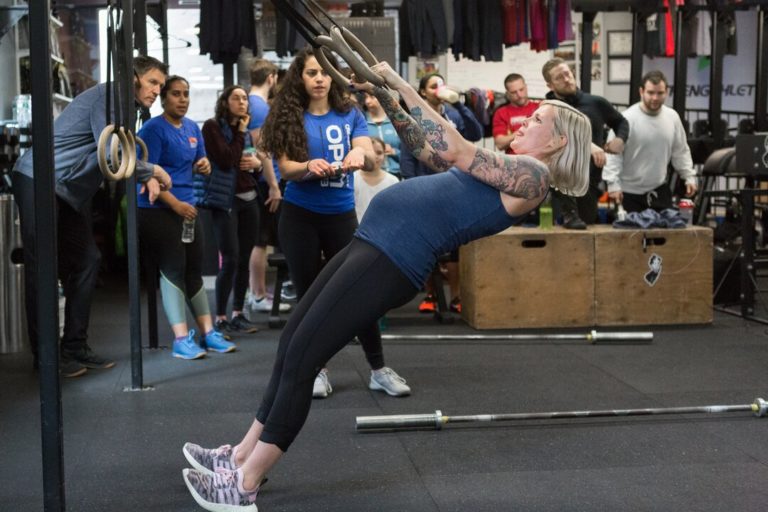Short Answer: Yes! Building strength, maintaining muscle mass, and continuing to adapt to life’s demands are all important when it comes to optimizing overall health, wellness, and longevity in pregnancy and in life — CrossFit can help foster all three.
Research shows that physical activity during pregnancy reduces the risk of preterm birth, gestational diabetes mellitus, and preeclampsia, as well as the incidence and severity of low-back pain and morning sickness. The CDC recommends pregnant women get 150 minutes of moderate-intensity, or 75 minutes of vigorous-intensity aerobic exercise per week, plus at least two days per week of weight training targeting all major muscle groups. Life also demands pregnant women engage with lifting and moving external objects, particularly for those who already have young children. CrossFit can be a great way to achieve these targets and prepare for the demands of everyday life, while training under the eye of a knowledgeable coach, surrounded by a supportive community.

A pregnant athlete performing a ring row.
Given all of the changes taking place in a woman’s body throughout pregnancy, it’s even more important to adhere to CrossFit’s principles, which we’ll unpack in detail below. These principles include the ability to perform and sustain proper technique before attempting to increase load or go faster, keeping effort level to only a bit more than the individual is accustomed to, modifying workouts to keep them appropriate for the woman’s current fitness level and the baby’s stage of development, and maintaining a safe workout environment.
During pregnancy, an athlete needs to learn proper mechanics for movements that take into account her changing body, working to develop consistency in movements and workout cadence, and only then chasing intensity. If consistency or mechanics begin to suffer during a workout, or if an athlete is unable to train consistently, the athlete and the trainer need to be quick to adjust, whether that be slowing down and taking more breaks, reducing the load, and/or reducing the complexity.
In addition, as a pregnant athlete chases intensity relative to her physical and psychological tolerances, she and her trainer need to consider a broader set of considerations, including her prior experience with training, the stage of development of her baby, any concerns raised by her doctor, and how her joints, muscles, cardiovascular system, balance, and more feel on any given day leading up to, during, and following the workout. In addition, pregnant women need to be mindful of getting too hot or excessively breathless during a workout, as some research indicates both of these factors can contribute to greater pregnancy risk, particularly for those who are not accustomed to vigorous exercise.
Being quick to scale is another feature of training safely during pregnancy, and both trainers and athletes may benefit from posting a movement substitution chart like this one, created by CrossFit Level 4 Coach Nicole Christensen, for quick reference within the affiliate. As a pregnant athlete notices discomfort or anything irregular during her workout, or her trainer identifies a difference in her movement, including instability with weight overhead or at the bottom of a squat, coning in the abdomen, or excessive curvature of the lumbar spine, they should be quick to modify or even terminate the workout. In addition, the athlete should stay in frequent contact with her doctor to communicate anything unusual she notices during or after workouts and make sure there are no concerns about the pregnancy or developing baby.
Finally, maintaining a safe workout environment is important for everyone. Throughout pregnancy, and especially in the latter half, it’s important to avoid impact with the stomach, whether this be resulting from a fall from a rope or a bar, from an errant barbell or dumbbell, or a trip onto a box or during a run. Many athletes choose to avoid snatches, rope climbs, and box jumps, particularly during the later stages of pregnancy, to avoid this chance of impact.
As with all things in life and training, there are safety considerations. The same applies to pregnancy. While there will always be more to learn when it comes to training pregnant athletes, this much is certain: building strength, maintaining muscle mass, and continuing to adapt to life’s demands are all important when it comes to optimizing overall health, wellness, and longevity in pregnancy and in life. CrossFit can help foster all three. Find a local affiliate near you to work with a credentialed CrossFit coach.
About the Author
 Sarah Hopping Estrella, M.S., CF-L3, found CrossFit shortly after narrowly missing qualification for the U.S. Olympic Team in the Hammer Throw. CrossFit was so effective in promoting simultaneous increases in strength, gymnastics skills, and metabolic capacity that she left a career in investment banking to open a CrossFit affiliate and serve on the CrossFit Level 1 Seminar Staff. She was an active CrossFit athlete throughout her pregnancy, and has been fortunate to coach many pregnant and postpartum athletes.
Sarah Hopping Estrella, M.S., CF-L3, found CrossFit shortly after narrowly missing qualification for the U.S. Olympic Team in the Hammer Throw. CrossFit was so effective in promoting simultaneous increases in strength, gymnastics skills, and metabolic capacity that she left a career in investment banking to open a CrossFit affiliate and serve on the CrossFit Level 1 Seminar Staff. She was an active CrossFit athlete throughout her pregnancy, and has been fortunate to coach many pregnant and postpartum athletes.
Ask a Coach: Is CrossFit Safe During Pregnancy
4